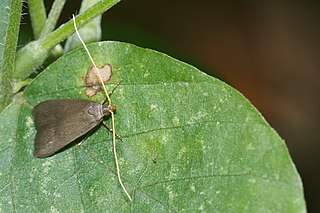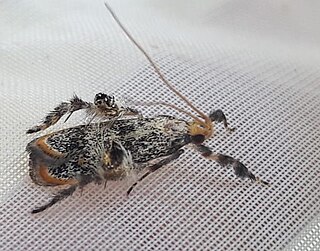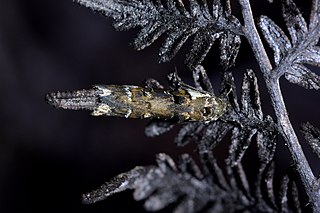
The Lecithocerinae are a subfamily of small moths in the family Lecithoceridae. They are found worldwide, but most species occur in South Asia. The subfamily is characterized by the male genitalia with a bridge-like structure connecting the tegumen and the valva, and the uncus almost always is vestigial with two lobes at the dorsal base, only exceptionally united into a broad plate, but never as a thorn or spine.
Cryptobotys is a monotypic moth genus of the family Crambidae described by Eugene G. Munroe in 1956. Its only species, Cryptobotys zoilusalis, was described by Francis Walker in 1859. It is found in Cuba, Jamaica, Puerto Rico, Central America and the southern United States, where it has been recorded from Florida.

Tisis is a genus of small moths in the family Lecithoceridae. The genus was erected by Francis Walker in 1864.

Heterocrossa adreptella is a moth of the Carposinidae family. This species was long considered the New Zealand raspberry budmoth however this was a taxonomic misinterpretation of the type material used to describe this species. This error was corrected in 1988 with the New Zealand raspberry budmoth giving its own species name Heterocrossa rubophaga. H. adreptella is endemic to New Zealand and has been collected in the Wellington Botanic Garden and been observed resting on mānuka branches.
Ericeia congressa is a moth in the family Erebidae. It is known to be found in South Africa, Madagascar, Mauritius and Réunion. It was described by Francis Walker in 1858.
Compsoctena connexalis is a moth in the family Eriocottidae. It was described by Francis Walker in 1863. It is found in South Africa.
Dichomeris contentella is a moth in the family Gelechiidae. It was described by Francis Walker in 1864. It is found on Borneo.
Tisis chalybaeella is a moth in the family Lecithoceridae. It was described by Francis Walker in 1864. It is found on Borneo.
Tisis meliorella is a moth in the family Lecithoceridae. It was described by Francis Walker in 1864. It is found on Borneo and Sumatra.
Tisis nemophorella is a moth in the family Lecithoceridae. It was described by Francis Walker in 1864. It is found on Borneo.
Tisis seclusella is a moth in the family Lecithoceridae. It was described by Francis Walker in 1864. It is found on Borneo.

Tisis mendicella is a moth in the family Lecithoceridae. It was described by Francis Walker in 1864. It is found in Sri Lanka.
Hygroplasta spoliatella is a moth in the family Lecithoceridae. It was described by Francis Walker in 1864. It is found in Sri Lanka.
Torodora spilotella is a moth in the family Lecithoceridae. It was described by Francis Walker in 1864. It is found in Sri Lanka.
Antaeotricha basiferella is a moth in the family Depressariidae. It was described by Francis Walker in 1864. It is found in Amazonas, Brazil.
Antaeotricha confixella is a moth in the family Depressariidae. It was described by Francis Walker in 1864. It is found in Amazonas, Brazil.
Antaeotricha conturbatella is a moth in the family Depressariidae. It was described by Francis Walker in 1864. It is found in Amazonas in Brazil and in French Guiana.
Antaeotricha impactella is a moth in the family Depressariidae. It was described by Francis Walker in 1864. It is found in Amazonas, Brazil.
Antaeotricha umbriferella is a moth in the family Depressariidae. It was described by Francis Walker in 1864. It is found in Amazonas, Brazil.

Trachypepla conspicuella is a species of moth in the family Oecophoridae. It is endemic to New Zealand and is found in both the North and South Islands. It is similar in appearance to its close relative T. euryleucota but tends to be paler. Its colouration imitates bird droppings. Larvae feed on leaf litter. Adults of this species are on the wing from November to February and have been observed resting on fences and walls.




